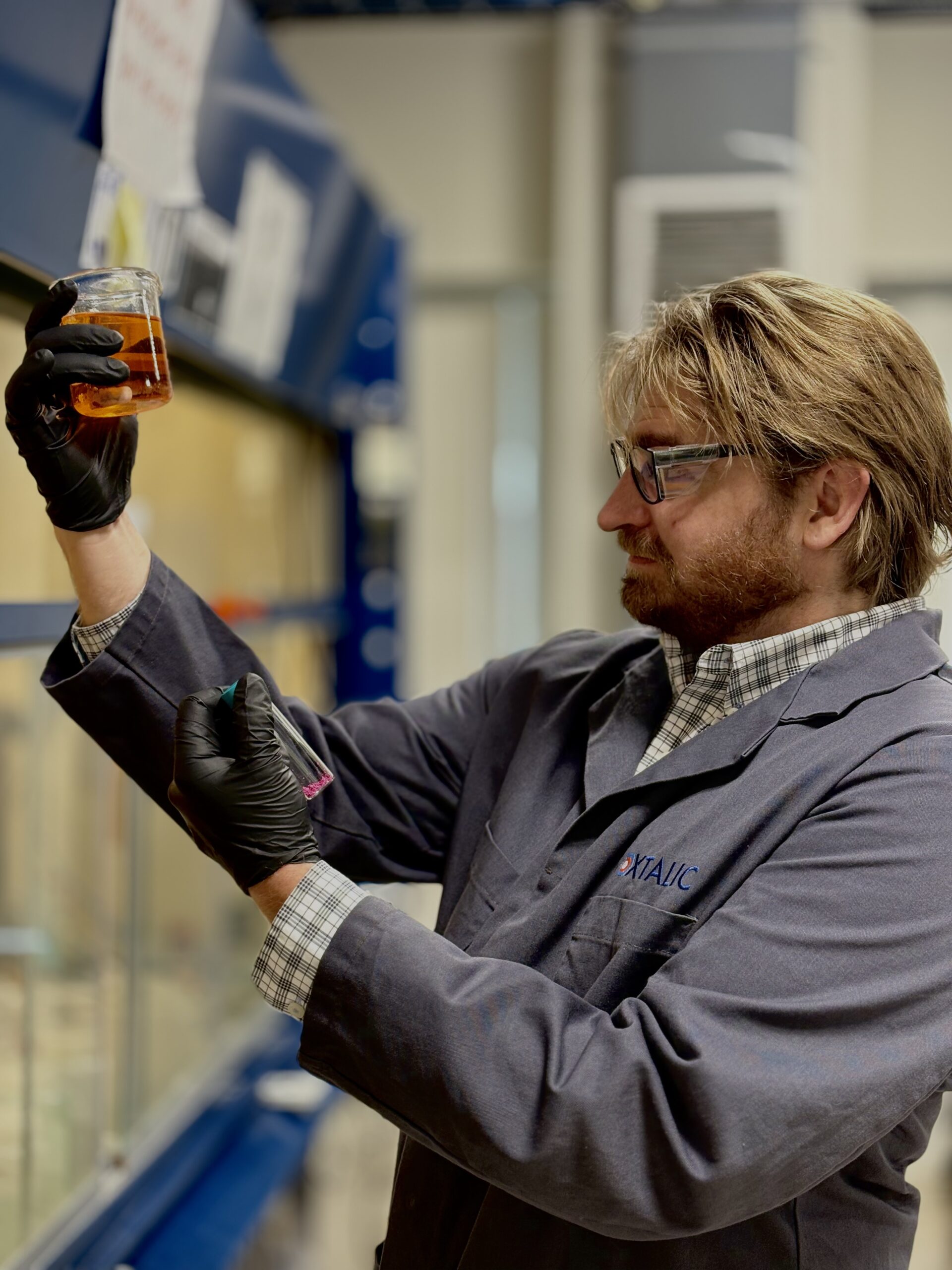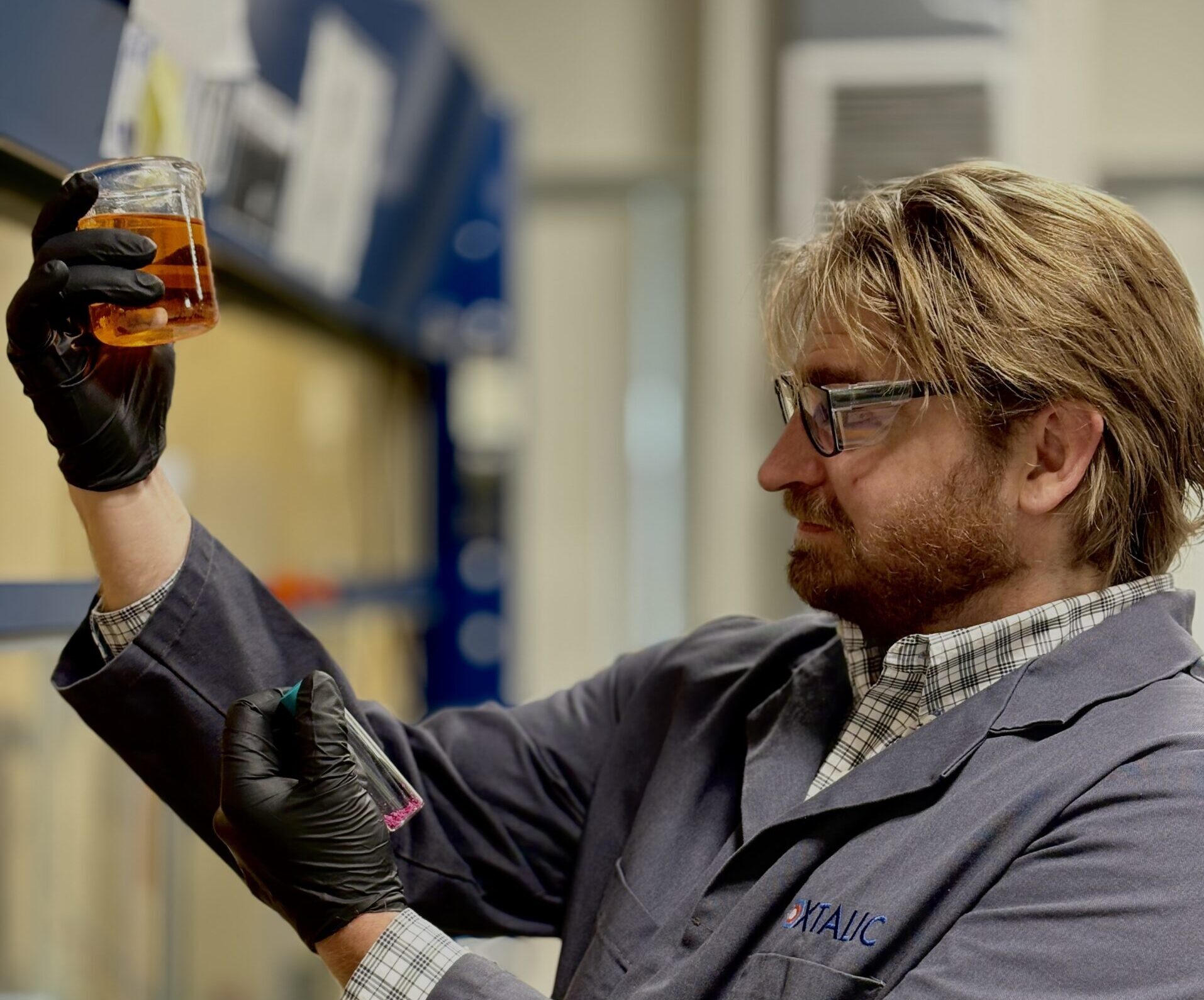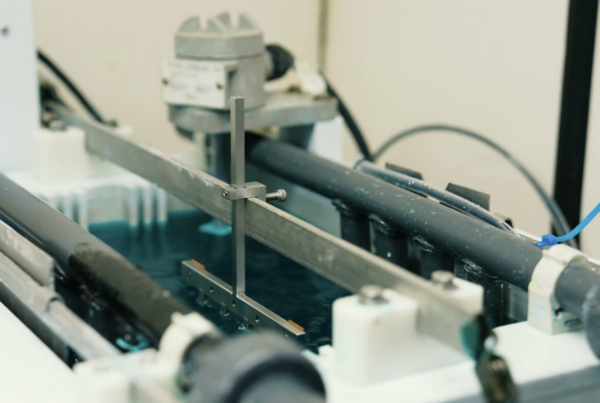Once an alloy concept is identified by our computational design model, the chemists and electrochemists at XTALIC translate this concept into a workable alloy production chemistry and plating process. We talked to Senior Chemist Dr. Jeff Monroe to find out what it takes to develop electrolytes to electroplate nanostructured alloys.
Contents
XTALIC: What would you say are the most important factors to developing a successful electroplating process?
JM: Stability, stability, and stability! Nobody wants to go through the headache of plating from a bath they can’t rely on, much less scale it up and implement it on an industrial plating line. Issues like precipitation, decomposition, and reactivity need to be addressed before the bath leaves the R&D lab.
XTALIC: Many of the alloys we target are known to be challenging systems from a chemistry perspective, such as Ni-Mo-Cr. What does it take to develop a stable electrolyte for such a complex system?
JM: That’s exactly why we have a team of experienced chemists and electrochemists, a vast literature and structural library, and many other resources. What we do at XTALIC simply wouldn’t be possible without significant investment. The electrolyte formulation space is multi-dimensional with infinite scale; it requires the expertise of the experienced scientists to bring an innovative new solution to commercial success. For instance, plating the Ni-Mo-Cr alloy at a variety of compositions is no simple task, each of these metals has a unique plating mechanism and requires precise complexation to get the desired metallic coating! But the first task in developing a plating bath is identifying complexing agents that allow synergy in the plating process. The final plating bath must comprise the perfect combination of metal complexes that are both safe and stable. Our commitment to sustainability also means avoiding the use of cyanide, despite its capability as a potent complexing agent.
XTALIC: Cyanide is a prominent complexing agent in electrodeposition and it is still in heavy use despite significant safety concerns and growing regulatory restrictions. What makes cyanide so effective?
JM: The features of cyanide that make it an amazing ligand for the electrodeposition process also make it toxic. The negative charge of cyanide is concentrated in the σ-HOMO molecular orbital and thereby imparts strong σ-donor capacity to cyanide. The π*-LUMO of cyanide is energetically favored to accept electron density from the metal ion d-orbitals, making it a notable π-acceptor ligand, which further enhances the M-L interaction. Cyanide is compact, so it can easily occupy the coordination sphere of metal ions without steric hindrance. This π-acceptor character of cyanide, in addition to its strong σ-donor character and compact size, make cyanide a strong ligand for many transition metals, some of which are vital parts of biological systems.
XTALIC: Are there other complexing agents like cyanide that aren’t so toxic?
JM: If we look at alternative ligands using the qualities of cyanide as a guide, oftentimes similarly toxic ligands are found. CO, a compact ligand with an even stronger π-accepting character, is quite toxic, and even inhibits COX and binds hemoglobin, similarly to cyanide. Phosphines are also strong σ-donor, π-acceptor ligands, however they also tend to be fairly toxic. Pyridines on the other hand are generally less toxic, but are bulky and weaker π-acceptors. That being said, some pyridines have found success in electroplating, and conjugated rings can impart interesting surface effects.
If we consider only the σ-donor character of cyanide, other ligands come to mind, like anionic carboxylates and neutral amines which are generally much less toxic. Given the lack of π-acceptor character of mono-carboxylates and amines, the chelate effect can be exploited to boost ligand strength using amino-acids, diamines, or poly-carboxylates.
XTALIC: So, finding something non-toxic isn’t the only challenge.
JM: The real challenge is multifaceted. The target complex has to be water soluble, which seems obvious, but can pose a serious challenge when formulating a multicomponent system. The formation of a neutral molecular complex can drastically reduce solubility, whereas formation of a salt is typically more soluble. For example, Pt(NH3)2(NO2)2 is insoluble below 70°C, and requires excess ammonia to form [Pt(NH3)4](NO2)2 in solution, which is soluble. Potassium silver cyanide KAg(CN)2, which is commonly used for the electrodeposition of silver, is soluble in water, however, silver cyanide (AgCN) is insoluble and requires complex-ion formation with excess cyanide, much like the halides of silver. Other ligands form complexes where solubility is less predictable; for instance, the copper-pyrazine system is more soluble with the nitrate starting material than the sulfate. Solubility is also often a function of pH and can be a serious barrier to electrolyte systems where a particular pH is required. Therefore, before you think you’ve found the perfect cyanide substitute based on literature research, you might want to make sure it forms a soluble complex first!
XTALIC: It sounds like toxicity and solubility can rule out many metal-ligand systems. What other considerations are part of the design?
JM: The ligand of choice has to work for the electrodeposition process, which again, might seem obvious, but the nuances of this statement can have massive implications on the development process. Cyanide works well in electrodeposition because it is both very strong and also releases metal ions readily on the cathode surface. EDTA is a very strong chelating ligand and forms soluble complexes with many transition metals, however, it binds so strongly that it is reluctant to release many metal ions for the reduction process. This makes the deposition very slow. Bipyridine is a σ-donor, π-acceptor chelate that binds too strongly for many systems for electrodeposition. Likewise, thio-donor ligands have been identified as suitable for the electrodeposition of silver, however, in several silver-alloy systems the sulfur group is oftentimes incorporated into the deposit, which is generally undesirable.
The anionic carboxylate ligand is a strong σ-donor and generally forms a soluble complex with most transition metals. When coupled with the chelate effect and the impressive flexibility of a ligand like citrate, a potential concern is that this ligand would be too strong for many systems. While this is sometimes true, the citrate ligand strength and chelate effect also depend greatly on pH and stoichiometry. That is to say, the complexing ability can be tuned by process conditions. Citrate is a powerful ligand and a very common alternative to cyanide, but it is not appropriate for the electrodeposition of every alloy system.
XTALIC: The electrodeposition of a single metal requires that all of these qualities are met, but we’re developing binary and ternary alloys. What additional challenges does this entail?
JM: The electrodeposition of alloys not only requires the above criteria are met for each target metal-ligand pair in solution, but also for the cross-pair and any potential mixed ligand complexes that might form. Furthermore, the target complexes of each metal aren’t arbitrary, they need to be designed such that the resulting reduction potentials of each metal complex allow alloy formation. Successful electrodeposition of an alloy requires that the reduction potentials of the metals are close to each other. Adjusting those electrochemical reduction potentials appropriately using complexing agents is a challenge.
Consider the Copper-Iron alloy system. Citrate seems like a suitable ligand to adjust the reduction potential of copper closer to that of iron, but that is not exactly the case. The iron-citrate complex is sufficiently strong that the reduction potentials are not close enough to allow facile alloy electrodeposition in a broad range of compositions. Furthermore, there are well documented nuances to the electrodeposition of iron alloys which make this classic approach less viable.
XTALIC: So, citrate might be appropriate for the electrodeposition of copper, but not necessarily some alloys of copper.
JM: Exactly, so the next challenge is engineering the selectivity of the ligand(s) for each metal ion in the alloy, while still ensuring long-term stability and safety. While citrate is a great example of a strong, non-toxic ligand that is used for the electrodeposition of alloys, it binds to a wide variety of metals strongly, i.e., it is relatively non-selective. For example, suppose we are designing a Silver-Iron alloy. Silver(I) is a considerably more noble metal than iron(II), if both are left uncomplexed in the electrolyte, only silver will electrodeposit. Therefore, if a single ligand is used, it must prefer silver(I) to push the reduction potential of silver such that it is close enough to that of iron(II), allowing both to plate simultaneously. Citrate would not work for this system, so one must find a ligand selective to silver(I). Ligand selectivity can be difficult to predict, although there are some potential routes, such as HSAB principles, coordination-#, and geometry, which often affect the deposition process.
XTALIC: When you were an undergraduate student learning hard and soft acids and bases principles, did you think you’d be applying it in your career as a scientist?
JM: Honestly, I really hoped I would! Much of what I learned in university is directly relevant, and what’s even more satisfying is when those HSAB principles work in practice! It’s not always that simple though – for a less obvious system, like Copper-Iron, the metals are similar in terms of HSAB properties, but very different in terms of reduction potential. In that case, we need to dig much deeper, leveraging our skills along with the knowledge in scientific literature. Beyond that, there are always exceptions to each rule-of-thumb in chemistry. When we think we have a good idea, the only way to know for sure is to try it in the lab, which is where you can find me and the rest of the XTALIC R&D team.

Dr. Jeff Monroe
Sr. Chemist
Dr. Jeff Monroe is a senior chemist at XTALIC. His experience in transition metal complex design, synthetic chemistry, and electrodeposition, are helping XTALIC lead the charge in developing industry-shaping nanostructured alloys. Jeff earned his Ph.D. in chemistry from Clark University and a BS in chemistry from Bridgewater State University.




